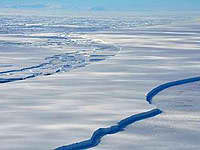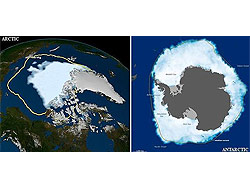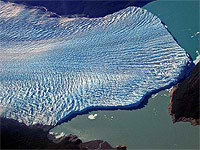    |

 |
|  | ||||||||||||||||||||||||||||||||||||||||||||||
Noticias | Terrestres | GlaciologíaCientíficos alemanes niegan desprendimiento de bloque de hielo en la AntártidaLos investigadores se basan en imágenes de la plataforma Wilkins captadas por el satélite europeo Envisat. Publicado: Sábado, 28/2/2009 - 19:49 | 2023 visitas.
Varios investigadores alemanes aseguraron que los satélites colocados en la Antártida no han detectado pruebas del desprendimiento de un bloque de hielo de 14.000 kilómetros cuadrados de la plataforma Wilkins, como aseguró el Consejo Superior de Investigaciones Científicas de España (CSIC). Ni en la imágenes del satélite alemán Terrasar, ni en las del europeo Envisat pueden verse ningún desprendimiento en la plataforma Wilkins, en la Antártida, subrayó la experta Angelika Humbert, de la Universidad alemana de Münster. “No puede saberse todavía cuando se romperá”, agregó por otra parte. Según sus estimaciones, cuando se produzca la descomposición, el bloque de hielo desprendido podría ser de entre 500 y 3.800 kilómetros cuadrados. Tampoco el profesor Heinrich Miller, del Instituto Alfred-Wegener de Bremerhaven, en el norte del país, cree que se haya producido el desprendimiento del que alertan los expertos del CSIC. “Según mi valoración de las imágenes de los satélites, desde hace un año, unos 2.500 metros cuadrados se encuentran en proceso de deshielo”, dijo. Tampoco la organización ecologista Greenpeace ha detectado un empeoramiento dramático en la plataforma Wilkins. “Los gigantescos icebergs en los que se ha descompuesto esa área helada comienzan a dispersarse por el Océano Austral”, advirtió por el contrario el martes el CSIC español, que también alertó de que el aumento del nivel del mar será una de las consecuencias directas.
| NoticiasImágenes
Videos
ArtículosEntradasLibros
| |||||||||||||||||||||||||||||||||||||||||||||||




 Imagen: British Antarctic Survey (BAS)
Imagen: British Antarctic Survey (BAS)





